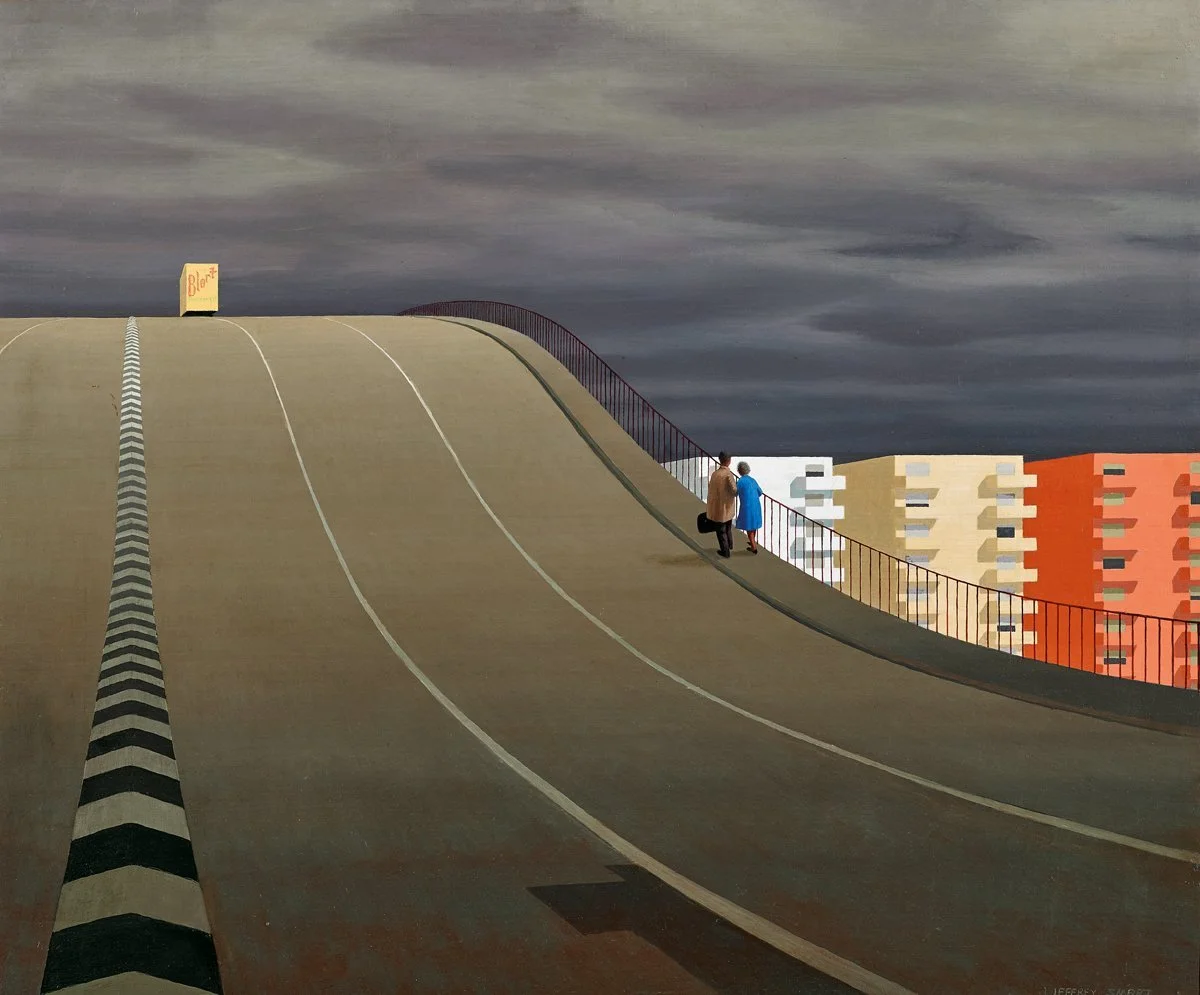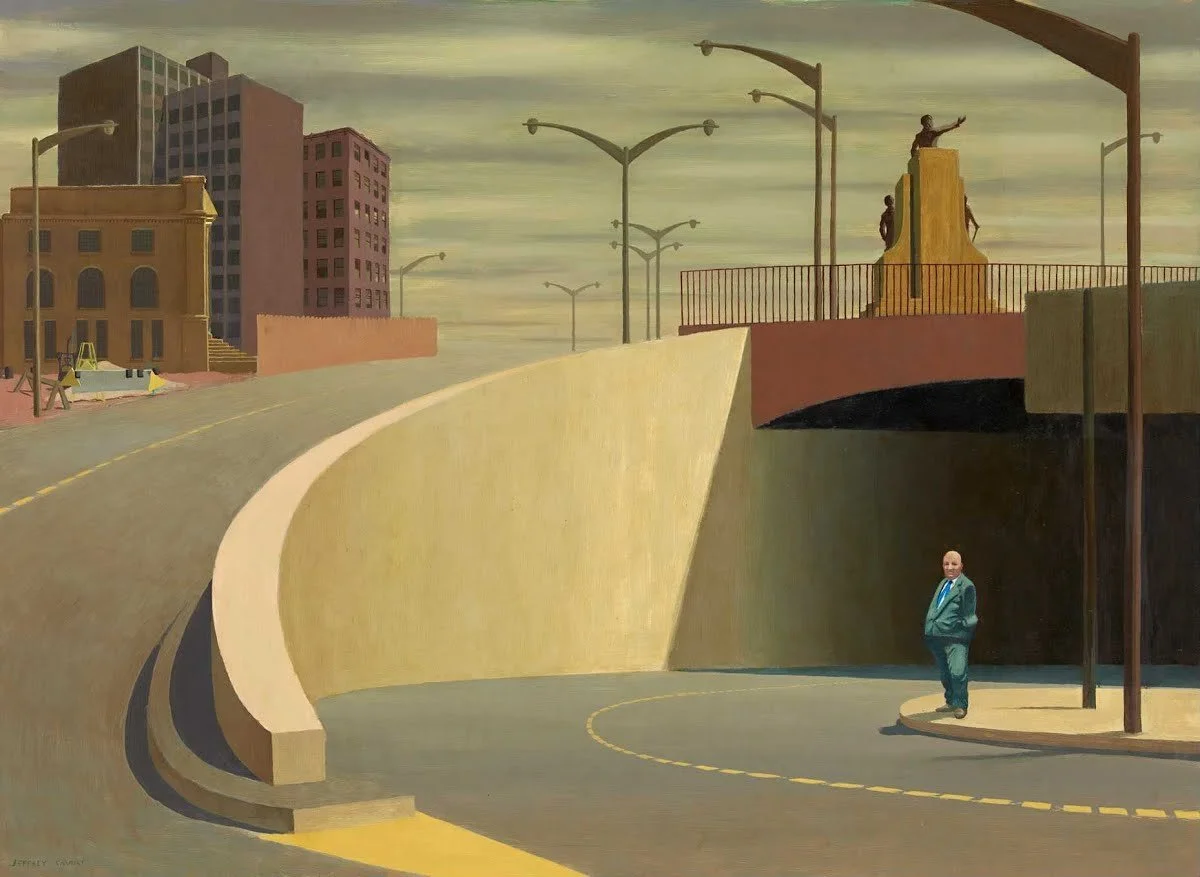“I find myself moved by man in his new violent environment. I want to paint this explicitly and beautifully.”
alma_mahler_feeding_the_birds_1968.jpg
Jeffrey Smart, an Australian modernist painter, was born on July 26, 1921, in Adelaide, South Australia. Renowned for his precise and geometrically structured depictions of urban and industrial landscapes, Smart's art captivated audiences with its meticulous attention to detail, vibrant colors, and a sense of both order and alienation.
Smart's early exposure to the world of art began at the age of 14 when he commenced studies at the South Australian School of Arts and Crafts. His formal education in art continued at the Adelaide Teacher's College and later at the South Australian School of Art. After completing his studies, Smart taught art in South Australia, gaining experience and honing his skills.
In 1948, Smart moved to Europe, where he immersed himself in the cultural milieu of post-war Italy and later settled in Tuscany. The landscapes and cityscapes of Italy became a central theme in his work, and his keen observations of urban spaces, highways, and industrial scenes set the stage for the distinctive style that would define his artistic career.
Smart's art is often associated with precisionism, a movement characterized by the use of sharp lines, geometric shapes, and a focus on industrial and urban subjects. His paintings feature scenes of highways, shipping containers, trucks, and architectural elements, all meticulously arranged to create a harmonious yet eerily detached atmosphere.
One of Smart's notable paintings is "Container Train in Landscape" (1975), which showcases his fascination with the geometric forms of shipping containers set against a vast, empty landscape. The painting reflects his ability to transform seemingly mundane subjects into compelling compositions that evoke a sense of solitude and contemplation.
Smart's urban scenes often feature a sense of order and stillness, with a deliberate absence of human figures. This intentional emptiness contributes to the enigmatic quality of his work, inviting viewers to project their own narratives onto the meticulously rendered spaces.
His mastery of color and composition is evident in works like "The Guiding Eye" (1965), where a solitary traffic cop stands against a background of red and yellow traffic signals. The juxtaposition of the human figure against the geometric elements creates a sense of isolation within the urban landscape.
Throughout his career, Jeffrey Smart's work received acclaim both in Australia and internationally. His paintings were featured in numerous solo and group exhibitions, and he was the recipient of various awards, including the prestigious Archibald Prize for portraiture in 1951.
Smart's contributions to Australian art extended beyond his paintings. He was a respected teacher, and his impact on the art community was acknowledged when he was made an Officer of the Order of Australia (AO) in 1999.
The artist continued to produce compelling and evocative works well into his later years. His dedication to portraying the urban environment with precision and flair remained a consistent theme throughout his career.
Jeffrey Smart passed away on June 20, 2013, leaving behind a legacy that reshaped the Australian artistic landscape. His distinctive vision and meticulous technique, which transformed the mundane into the extraordinary, established him as a leading figure in modern Australian art. Smart's paintings continue to be celebrated for their unique blend of realism, abstraction, and the exploration of the human experience within the urban milieu.
approach_to_a_city_1968.jpg
cahill_expressway_1962.jpg
My Rating: 8/10
My Rating: 9/10
p.s.
The CMYK color model (also known as process color, or four color) is a subtractive color model, based on the CMY color model, used in color printing, and is also used to describe the printing process itself. The abbreviation CMYK refers to the four ink plates used: cyan, magenta, yellow, and key (black). The model works by partially or entirely masking colors on a lighter, usually white, background. The ink reduces the light that would otherwise be reflected. Such a model is called subtractive because inks "subtract" the colors red, green and blue from white light. White light minus red leaves cyan, white light minus green leaves magenta, and white light minus blue leaves yellow. In additive color models, such as RGB, white is the "additive" combination of all primary colored lights, black is the absence of light. In the CMYK model, it is the opposite: white is the natural color of the paper or other background, black results from a full combination of colored inks. To save cost on ink, and to produce deeper black tones, unsaturated and dark colors are produced by using black ink instead of the combination of cyan, magenta, and yellow.






